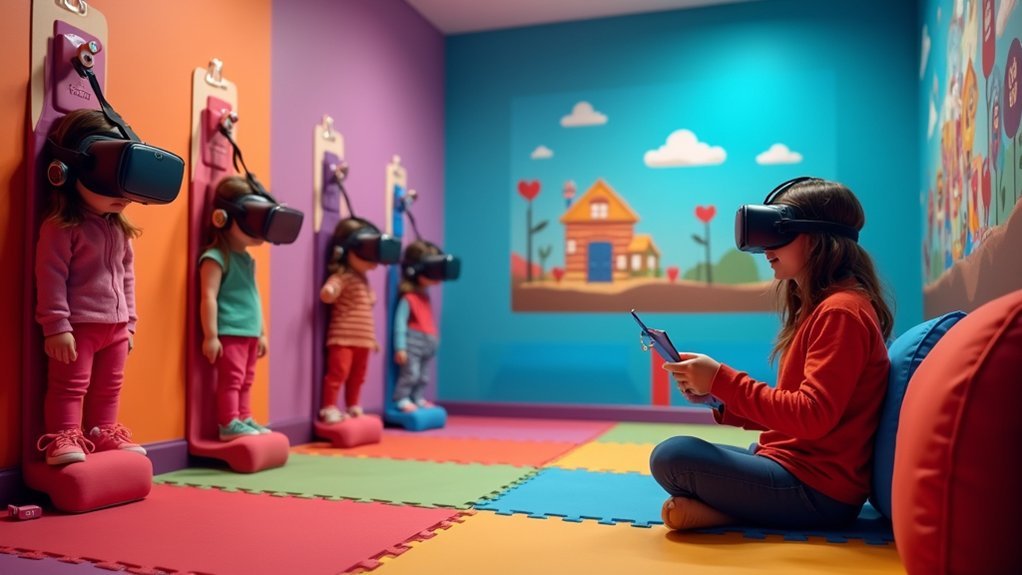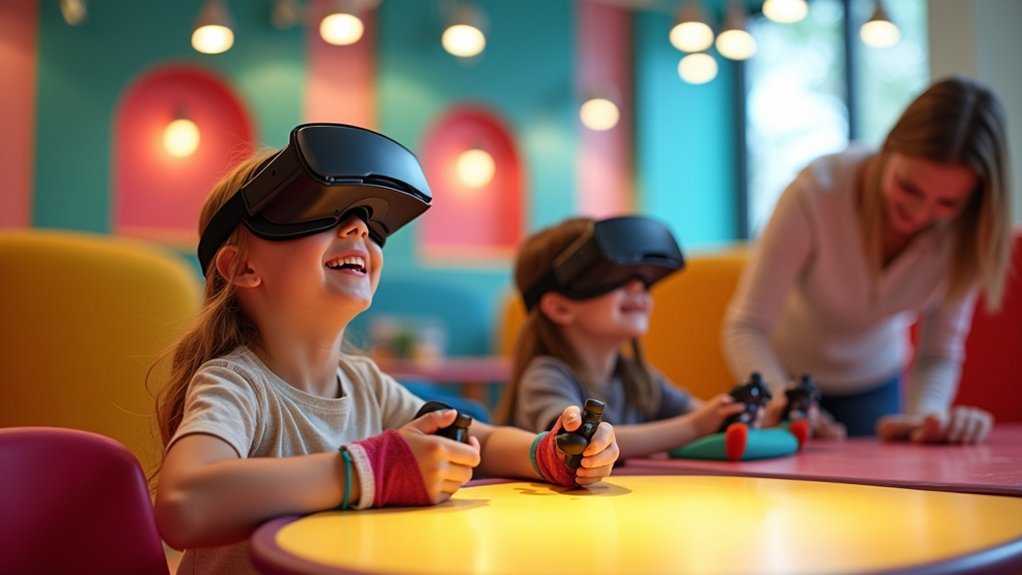You’ll need to establish three key safety measures for your child’s VR play area. First, clear a minimum 6.5 x 6.5 foot space by removing furniture, toys, and rugs that could cause tripping. Second, configure your VR system’s built-in virtual boundaries within this cleared zone and actively supervise sessions to monitor spatial awareness. Third, implement strict age-appropriate time limits—maximum two hours daily for teens, shorter for younger children—while watching for fatigue signs. These fundamental steps lay the groundwork for thorough VR safety protocols.
Clear Physical Obstacles and Create Adequate Movement Space

When setting up a VR play area for your child, you’ll need to establish a clear zone of at least 6.5 x 6.5 square feet completely free from obstacles.
Start by removing furniture, toys, and rugs that could cause tripping during VR use. This clutter-free environment prevents accidents while your child enjoys their immersive experience.
Clear all furniture, toys, and rugs from the VR space to create a safe, accident-free environment for your child.
Position the safe play area away from walls, doorways, and staircases to maximize movement space. You’ll want to clear physical obstacles that might interfere with natural motion during gameplay.
Choose comfortable flooring like carpet to cushion any falls and enhance physical safety.
Conduct regular checks of the designated zone before each VR session, ensuring nothing has been inadvertently placed in the path that could disrupt your child’s safe virtual adventures.
Establish Virtual Boundaries and Safety Monitoring Systems
After clearing your physical space, you’ll need to configure the VR system’s virtual boundaries to create digital guardrails for your child.
Most VR headsets feature built-in boundary systems that establish a safe space for children using virtual reality. Set up these virtual boundaries carefully, making sure they’re well within your clutter-free space to maintain ideal tracking accuracy.
Implement consistent safety monitoring by supervising your child during VR sessions. Watch for signs they’re approaching boundary limits and address any safety concerns immediately.
The headset’s alert system will warn when boundaries are approached, but your oversight remains vital.
Maintain open communication about staying within virtual limits and the importance of spatial awareness.
Regularly reassess and adjust your play area boundaries to guarantee continued safety as your child grows and their movement patterns change.
Implement Age-Appropriate Time Limits and Supervision Protocols

Establishing virtual boundaries protects your child physically, but managing their VR exposure requires equal attention to time limits and active supervision.
Age-appropriate restrictions guarantee children’s well-being while maintaining VR’s educational benefits.
Implement these supervision protocols for safe VR experiences:
- Set strict time limits – Children aged 13 and over shouldn’t exceed 2 hours daily of VR use, with younger children requiring shorter sessions.
- Monitor for discomfort signs – Watch for blurry vision, posture changes, or fatigue that signal it’s time for breaks.
- Maintain active parental supervision – Stay present to observe emotional reactions and guide children through challenging content.
Use parental controls to enforce these boundaries automatically.
Communicate with your children about recognizing when they need breaks, helping them develop self-awareness about their VR tolerance and promoting healthy technology habits.
Frequently Asked Questions
How to Make VR Safe for Kids?
You’ll need to create a clear 6.5×6.5 foot obstacle-free space, monitor kids constantly, use built-in safety boundaries, limit sessions to two hours daily, and guarantee good lighting without reflective surfaces.
How to Child Proof VR?
You’ll need to create physical boundaries around the play space, adjust headset settings for age-appropriate content, establish time limits, guarantee proper supervision, and remove hazardous objects from the area.
What Is the Recommended Area for VR Play?
You’ll need a minimum 6.5 x 6.5 square feet of clear, open space for safe VR play. Choose areas away from foot traffic, doorways, walls, and staircases to prevent accidents during movement.
What Are the Safety Precautions for VR?
You should clear obstacles, monitor usage constantly, limit sessions to two hours daily, adjust headsets properly for comfort, set virtual boundaries, take regular breaks, and choose age-appropriate content while maintaining open communication.
In Summary
You’ve now got the essential framework for creating a safe VR environment for children. Remember, you can’t just set up the space and walk away – you’ll need to actively monitor each session and adjust boundaries as needed. Don’t skip the time limits, even if your child’s begging for more time. By following these three guidelines consistently, you’ll guarantee your child enjoys VR safely.





Leave a Reply